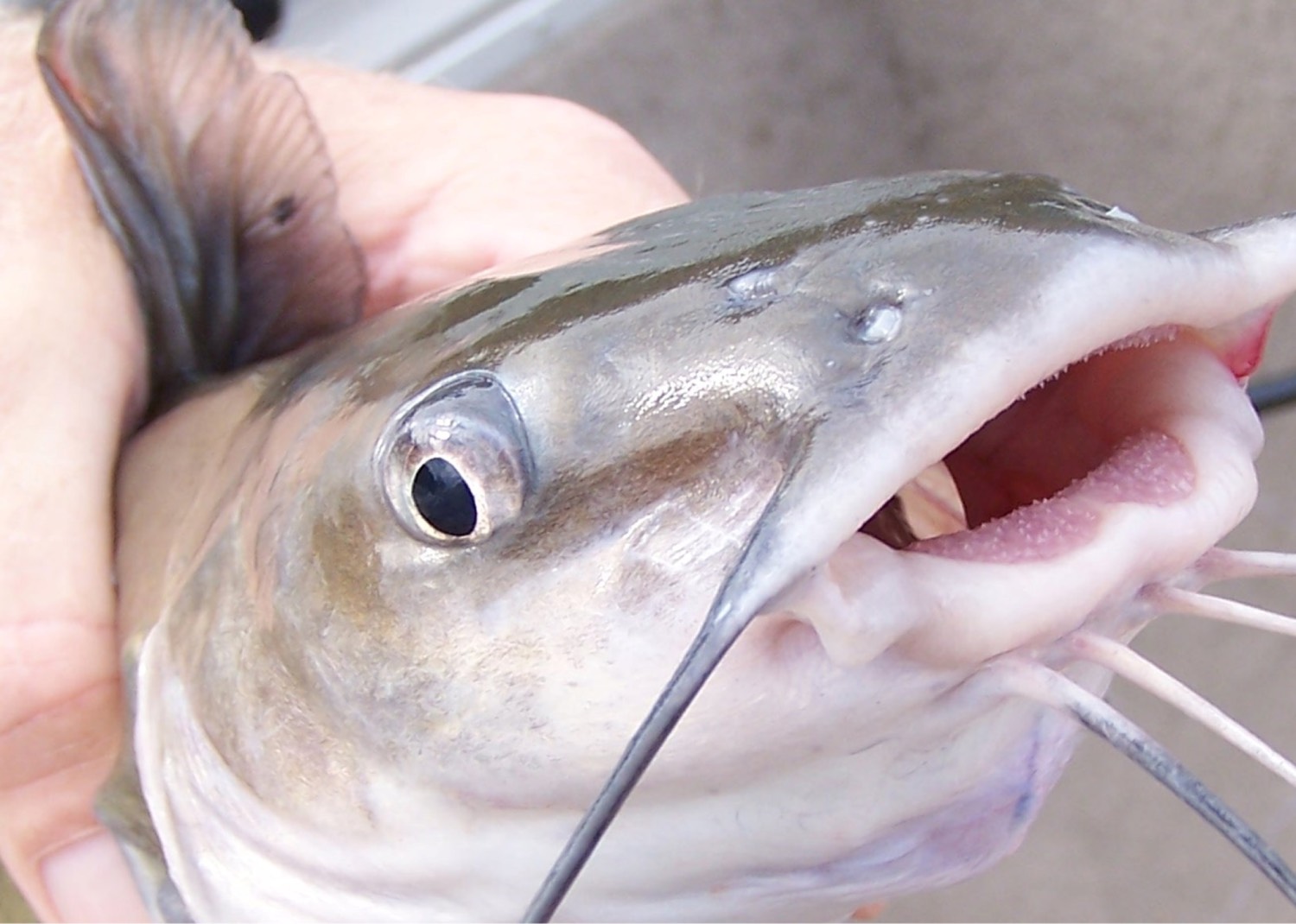Phillip Gentry
In the hierarchy of catfishing, three species top the charts as the most desirable for catfish anglers. Number one is the blue catfish, the king of the catfish world, the bruiser that can achieve sizes closely resembling a Volkswagen Beetle, according to scuba divers who dare to venture into the depths near the dam.
Second on the list is the flathead catfish — the mudcat — the night stalker whose only nemesis is a bikini-clad young lady or barbwire-tattooed redneck looking to wrestle the beast from its underwater lair.
Unfortunately, third and fourth on the list tend to be repeats of number one and two because channel catfish routinely come in number five on a popularity contest with only three participants. The saving grace of the channel catfish is its undeniable place on the table after a romp through Lake Crisco. This is somewhat unfortunate because as light tackle fighters and angling quarry, there’s a lot to be said for channel catfish.
Of the three catfish species, channel catfish are the most widespread, calling nearly every state in the Union home, plus locations in Canada and Mexico. This is owing primarily to being the first and most popular fish species raised in commercial aquaculture for food purposes.
About Channel Catfish
Channel catfish are omnivorous feeders and will readily take live and dead creatures along with a variety of unusual baits that run the gamut from grapes to soap to hot dog wieners. This is because most catfish species are well-known for their keen sense of smell.
When targeting big catfish species like the channel catfish, one of the best fishing tips for savvy anglers is to take advantage of their senses and use foul smelling bait to tempt the fish into biting. Channel catfish are often labeled as scavengers, but the label is mostly a misnomer, owing largely to the channel catfish’s highly developed sense of smell, which they rely on to feed. In that regard, they are similar to crappies, who use their well-developed eyesight to hunt spawn and smaller fish species.
Fish have olfactory pits on each side of their head. Each pit has two nostrils. Water comes in one nostril and goes out the other. The olfactory pit has folds inside that are lined with sensitive tissue for detecting food. Channel catfish have 140 of these folds in each nostril granting it the capability to detect one part food in 10 billion parts water. In comparison, a rainbow trout has about 18 folds, a largemouth bass has roughly a dozen and a bluegill has up to 40.

Best Baits for Channel Catfish
For warm water fishing, using baits that put off a continuous stream of odor often work best to help the fish locate the bait. This is the reason so-called “stink baits” are a favorite summer channel catfish bait.
Some less obtrusive baits include cut bait fish, such as shad, herring or other high oil-content fish. Other forms of live bait, such as shrimp, and invertebrates such as crawfish and night crawler worms, are also good choices for catching catfish due to their olfactory output. If you prefer to use non-live natural bait, chicken livers produce strong odors similar in intensity to purpose-built stink baits.
Frequently changing baits and maintaining a strong scent trail are major contributors to fishing success, as channel catfish rely on scent to locate bait from a distance. Neglecting to do so can significantly impact your fishing success.
Best Rig for Channel Catfish
Rigging for channel catfish is also a relatively simple matter. For fishing in static waters of lakes or ponds, a Carolina rig is the most effective. The weight associated with the Carolina rig should be contingent on the amount of current and depth of water being targeted. Most still-water situations with depths of 20 feet or less would require no more than ½ oz. of lead to anchor the rig. Sometimes no more than a split shot, pinched straight to the line, will do the trick.
In current situations, rivers and streams with moderate water flow and depth may require up to 1-½ to 2 ounces of lead. In many situations, the type of sinker used, such as a flat, no-roll sinker, often works better than a heavier round weight. Consider incorporating a bobber in your setup to ensure your bait is being presented at the correct height.
Another reason channel catfish get a less-than-desirable rating on the angling scale is the tendency for anglers to use heavier than necessary tackle. A common overpower situation occurs when blue or flathead catfish anglers using heavy-weight tackle wind up with decent-sized channel catfish on the line. Unless underwater structure dictates heavier tackle, medium to light action rods with 10-pound monofilament fishing line are sufficient to land nearly any channel cat — from the smallest to the biggest fish.

Best Location for Channel Catfish
In all the above scenarios, location is important when targeting warm water channel cats. Like most gamefish species, channel cats tend to spend the majority of daylight hours in deeper water, away from sunlight and boat traffic in water of moderate (20-25 feet) to deep (40 feet +) depths.
One standout daytime location to find channel catfish is overhead bridge crossings, where the structure provides shade, depth and cover. Feeding activity during the warmer months tends to ramp up in low-light situations, with summer catfish becoming more active at dusk and dawn and cyclical feeding overnight.
In bodies of water where baitfish schools move early and late, expect to find channel catfish on typical ambush feeding sites such as long points and humps where catfish often clean up after other larger predator species.
Regardless of its standing on the catfish popularity scale, channel catfish are a reliable quarry when the goal is a cooler full of filets or when other, more temperamental species aren’t willing to cooperate.
Tips and Strategies to Catch Channel Catfish
Even if you know how to catch catfish of other species, channel catfish can surprise even the most experienced anglers with the best equipment. Use the following tips and tricks to increase your chances of success and come home with a plentiful catch.
- Pay Attention to Water Temperatures. Channel catfish are highly sensitive to changes in the water’s temperature and will adapt their feeding habits. The warmer the water, the more likely they are to feed. Channel catfish exhibit the most aggressive feeding behavior in water temperatures between 70°F and 85°F.
- Mind the Weather Report. Catfish can sense the changes in barometric pressure caused by the weather and often change their feeding behavior accordingly. For instance, if your local weather reports an approaching storm, the pressure is dropping, and your local channel catfish may start feeding more aggressively. However, if the pressures are constant, such as during a bright and sunny day, they may be more passive and lethargic, making it harder to catch fish.
- Keep Your Scent Trails in the Right Direction. After finding a good spot to start catching channel catfish, anchoring your boat correctly can help you attract the catfish more effectively. Always anchor upstream of the location you intend to target and then cast your rod back into it instead of anchoring downstream and casting in. It will allow the scent emitted by your bait to flow downstream and minimize the risk of spooking fish.
- Try Chumming Your Area. Chumming is a technique designed to take advantage of the channel catfish’s well-developed sense of smell. It consists of deliberately throwing small pieces of odorous bait into the water to incite catfish to swim up and attract them to the bait on your circle hook. This technique can be done with the same types of bait you use on your hooks. But don’t throw too much chum into the waters. If you overdo it, they will feed until satisfied and may lose interest in other bait, causing them to swim away.































